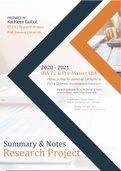Summary
Research Project blocks 5& Summary FULL slides/notes content compilation
- Course
- Institution
Contains all content from the two first blocks of the Research Project course. No information is left out, and I've added the occasional extra info or link to understand certain material. Priced lower as the recommended (non-mandatory) literature is not part of this summary.
[Show more]



